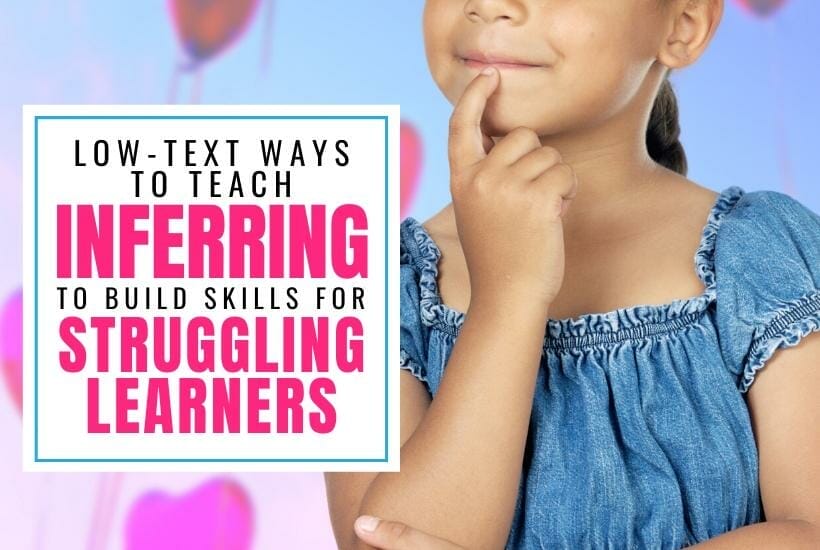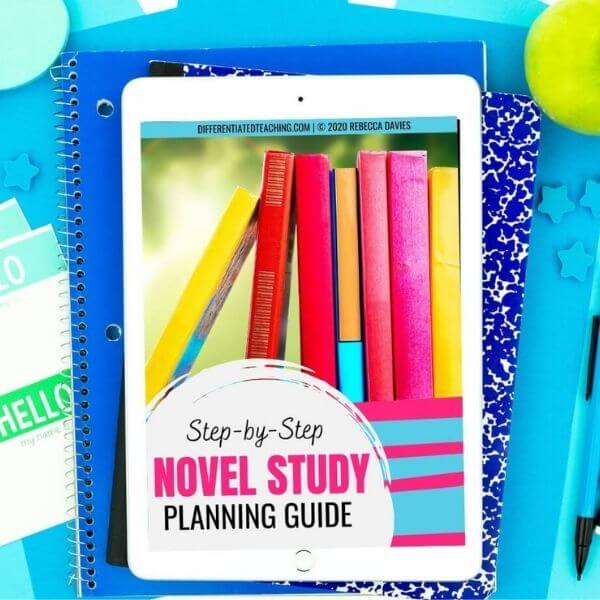5 engaging ways to make inferring approachable to struggling or reluctant readers
The ability to infer is a crucial skill that all children should be supported to develop. Simple retrieval comes easily, but inference and deduction need a bit more work. Many of us refer to it as becoming a text detective by ‘reading between the lines’.
This skill becomes even more challenging to develop for struggling readers. When students spend the majority of their focus decoding, they often miss important details that would allow them to generate inferences. However, this doesn’t have to be the case.
Today I want to share some ways to help your struggling readers develop their ability to infer.

Fun ways to teach inference & deduction without a ton of text
It can be easy to rely on text to when you begin introducing and practicing higher-level comprehension skills, like inferring. However, this leaves many struggling readers lost and confused and results in them falling even more behind.
The five strategies outlined below allow all students to access your instruction and practice the strategies they’ll need for text-based inferencing without having to spend a ton of time finding level-appropriate text for each group or worrying that your struggling readers will be left behind.
1. Video clips
Developing inferencing skills should not be limited to just texts on paper. Visual literacy is essential, too. Plus it is a great way to build this essential higher-level comprehension skill when students are still learning to decode efficiently.
The use of film clips to teach anything is often welcomed with open arms by the pupils. Take Pixar’s For the Birds, for example. It is an excellent example of a short, animated film that suits this learning outcome. There is no dialogue, and it is up to you, as the viewer, to interpret what might be happening and why.

This short is perfect for linking to anti-bullying and emotions. Other video clips that could work are advertisements, music videos, or even scenes from soap operas or popular television shows shared with the sound muted.
2. Photographs and pictures
Photographs are another fantastic way of getting your students to make connections between their background knowledge and the details.
Have students look closely at the people’s faces and analyze their body language. What might have occurred?
What evidence is there in the image to support your thoughts?
Using photographs of people or situations pupils will recognize can also be useful and can help ensure they have the background understanding to infer beyond the image.
When it comes to texts, we often use things we already know about the character’s personality to help us deduce information. It can be the same when it comes to photographs involving familiar faces or places. Once upon a Picture has a wealth of pictures which could be used in this way.
If you’ve got a larger group of struggling readers or students at extremely different reading levels, using a picture format can help level the playing field when it comes to independent activities, like morning work.
To find out more and see how I used this format in my classroom, read this article: How to Use Photos to Build Comprehension for Struggling Readers
3. Roleplay
Some teachers feel like roleplay is only suitable for younger learners. However, roleplay offers a variety of benefits that can help build a range of skills, including inferring.
Have a box of props and clothes for learners to choose from. Demonstrate for them first by putting on a sun hat and wheeling a suitcase behind you.
What can the children guess about you and what you are up to? Perhaps you are going on vacation or you’ve just come back.
Discuss whether these are the only possibilities. What could you do to change their mind? There is so much discussion to be had around this, and your students will love taking a turn themselves.

If you want more control over the direction students take this activity, you could prepare a deck of cards with a variety of scenarios in advance. Have your learner select a card and props to act out their selection.
One example could be ‘showed up at school wearing a fancy dress on the wrong day’ – that is sure to have the children laughing by the end.
4. Text-picture matching
As your readers become more prepared to infer using text, you can start to incorporate some reading into the activity. Alternatively, you can partner students so a strong reader is with a weaker reader to offer support. This activity is perfect for that format.
Simply find some pictures all based in the same location, e.g. the library, and write a short paragraph of text to go with each one. Have your students read the passages and infer to decide which paragraph goes with which picture.
Use the phrase ‘show not tell’ when referring to how the author has planted a certain seed in your mind. Remind them that the writer has given you clues and they, as text detectives, need to use those to solve the mystery and match the text to the pictures.
Challenge your learners further by displaying four similar images on the screen. Ask them to write text to match one of them and their partner can read their work before guessing.
5. Same situation, different character
This activity can be a fun challenge and is great for partners or small groups.
Start by giving students a photo and 3-4 different characters. For example, you might provide them with a photo of an expensive sports car and then the names of four characters and a few details about their background, e.g. Billy the lottery-winner who just got his prize money.

Next, give students a sentence like ‘X sat behind the wheel of the car and sped off down the highway’.
Change the sentence by thinking about the motives of the character. ‘Billy popped the key in the ignition, revved the engine, and sped off down the highway’.
Discuss their choices. Why did he rev the engine? Perhaps he was excited he could finally afford a fancy sports car.
Why did he speed off? Where was he going? You would then get the children to repeat this assuming a different character was entering the car and driving away. It promotes valuable discussion.
Again, this requires little decoding, which makes it a great option for struggling readers and allows them to participate at the same level as their peers. You might also use this activity to spark a discussion about the influence of point of view.
Alternative comprehension activities build confidence and reading competency
Finding alternative ways to teach and assess higher-level comprehension skills for struggling readers is important.
When readers struggle with decoding they often feel overwhelmed or like they lack the skills to be good readers. By finding ways to incorporate activities that aren’t text-dependent into your instruction, you allow your learners to access and master the foundational components of the skill without the barriers of the written word.






